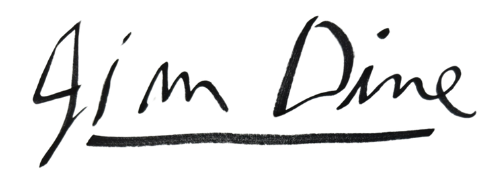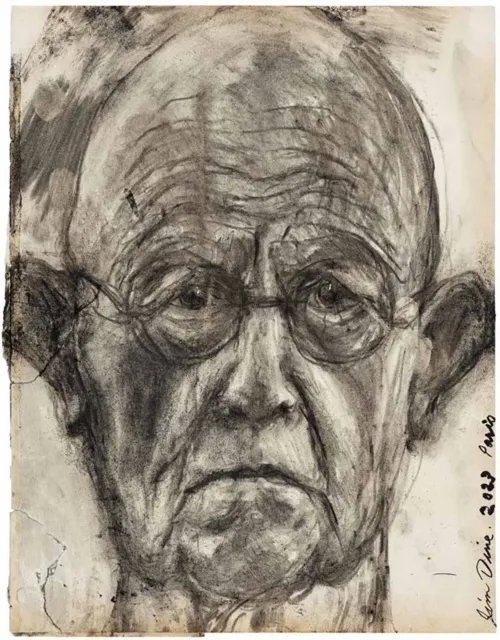THE OBSERVER: The Invincible Jim Dine On Drive, Draftsmanship and His Own Mortality
“If you have something to say, you say it. You don’t sit on your ass. I’m lucky. I wake up in the morning and I have something to say.”
By Dian Parker • 01/02/24 12:00pm
Artist Jim Dine is a painter, sculptor, printmaker and poet—one who exemplifies what it takes to master a craft. He works seven days a week, 365 days a year, except when he’s traveling between studios and exhibitions, which he refers to as a “holiday.” Dine’s work day begins at 9 a.m. At 3 p.m., he takes a one-hour break, then resumes working until 6 p.m. From there, he—still keeping to a schedule—spends an hour working out, cooks and eats dinner and reads until bed. It would be a challenging schedule for anyone to maintain, but Dine is 88 years old with no intention of letting up or slowing down.
I was fortunate to speak with Dine at his studio in the St. Gallen Foundry in Switzerland where he is in the process of building twenty-four bronze sculptures for the 60th Venice Biennale. His show will be a collateral event at the Palazzo Rocca.
Dine is a no-nonsense man, answering my questions simply, openly and honestly. When I asked if he felt driven, he said, “I wouldn’t call it driven. I act upon what is given to me, that’s all. And I don’t waste time. It’s not being driven. It’s a responsible act. If you have something to say, you say it. You don’t sit on your ass. I’m lucky. I wake up in the morning and I have something to say.”
For the past 80 years, Jim Dine has said a lot. He has had solo exhibitions of his paintings, prints and sculptures all over the U.S. and Europe, but at the center of all his practices is drawing. Dine is a master draftsman, and you can see his skill in drawings of tools, skulls and classical figures like Venus, and in his portraits. Currently on view at the Bowdoin College Museum of Art are 74 portraits created over the last 65 years: “Jim Dine: Last Year’s Forgotten Harvest.”
The portraits are of friends and family, highlighting his exacting process of observation. In them, he works and reworks countless times, allowing the viewer to see his process on paper. There is a muscularity in these drawings, as if Dine is attacking the paper. Using an 8b pencil, charcoal and sometimes watercolor, he adds, erases, smudges, wipes, layers and scrapes, sometimes piercing the paper, even leaving a phantom limb, like in the Susan Rothenberg portrait. Dine’s portraits are like Giacometti’s, dark and brooding, thick with material. Some of the drawings in the exhibit are of friends who have died, with all the graying of the paper from erasure appearing like ghosts hovering behind the heads. Long-time friend and colleague, printmaker Aldo Crommelnyck, is drawn with tenderness and depth. Portraits of his three sons, his first wife Nancy, and his current wife, Diana, are all a celebration of Dine’s tenacity and devotion to his craft. Two portraits of the poet Rimbaud exemplify the poet’s fierce genius. Each portrait is a character study, revealing the individual’s unique personality. No small feat.
The portraits are a donation to the museum from Dine. “Bowdoin is one of the oldest college museums in the country,” he said. “It’s nice to know they’re all together and taken care of by responsible people.” In recent years, Dine has donated artworks to several other institutions. He made a gift of 250 prints to the National Gallery of Art in Melbourne, thirty historical works to the Centre Pompidou in Paris and 270 prints to the Snite Museum at Notre Dame University, to name a few.
I reminded him of something he had said years ago, expressing that he had found it a failure in modern art that artists aren’t draftsmen. “I don’t know if it’s a failure; it just makes it less interesting for me. Not modern art but contemporary art. I venerate old draftsmen—I was born a draftsman. I’m a Luddite. I’ve been too busy drawing. I know what I can and cannot do. I’m not interested in a social life. I’ve no time for that. The people I would really like to talk to are dead. It is quite constructive if you think of it that way. It gives you more time.”
I asked if he felt like he was running out of time, and he said, “No. Not at all.”
Shuttling between Switzerland for his sculptures, Paris where he lives, paints, and writes poetry, Germany where he makes prints and books, and his land in Walla Walla, Washington—as well as attending his openings in Venice, New York and around the world—seems like an exhausting way of life. Dine said, “I get up, have breakfast, work and work out. It’s a very boring life. I’m a boring guy.” When asked about his Pantheon of influences, he replied, “I’ve been influenced by everything I’ve seen. I have a life in art. I have relationships. I go to museums. Everything I do influences me.”
He then paused for a few moments. “And I demand to get it out. I demand better of myself. I want to speak that way in my hand. And my left hand has held me in good skill. I’m really focused on one painter now: me. I have work to do.”
For the Venice Biennale, Dine will show the aforementioned bronze sculptures plus seven paintings and four drawings. The paintings are large: 7 feet square… 14 feet square… one is 12 feet by 6 feet… all in different mediums, often mixed with sand. “I’ve been very lucky. People sell my work, which pays for the expensive production cost of making the sculptures.” Dine has been working in the Switzerland foundry since 2020.
“The foundry is exceptional, with eighty-three employees who are at the pinnacle of sculpture production in virtually every material,” his assistant, Daniel Clarke said. “Jim works there with plaster and wax, then the pieces are cast into bronze, and most recently a polymer resin. He also uses the U.S. foundry Blue Mountain Fine Art, in Baker City, Oregon.”
Clarke also talked about Steidl publishers in Göttingen, Germany. “Jim met Gerhard Steidl, the founder, in 1998. They began a collaboration in 2000 making more than 30 books together. Their relationship is unique, built on mutual respect and genius. The books range from show catalogs to poetry to conceptual publications.” Dine’s wife, the photographer Diana Michener, also publishes with Steidl.
Dine currently prints, primarily in woodcut and lithography, in Apetlon Austria with Steindruck, a small print shop run by Gabi Pechmann and Christoph Chavanne. He spends summers in Walla Walla, Washington, where he has a large garden that he works himself. He makes woodblocks and prints there, and paints. He also paints in Paris, and everywhere he goes, he writes poetry. “I’ve worked with Jim for twenty years and he’s never taken a vacation. We have but he hasn’t,” Clarke said. “He uses travel and displacement as a method. We are very often on the road.”
I asked Dine about all these places he works and how he manages to keep going. “I acted upon my emotions about where I wanted to work and sought out the best craftsman. And I’m lucky. My mortality is not pressing. I’m able to work, and I’m grateful for that.”






